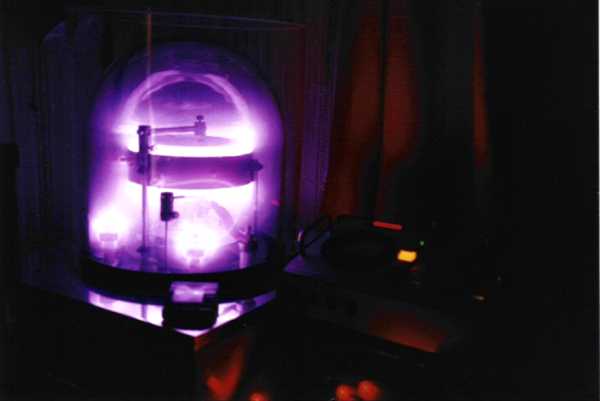

| Experiments Menu | Teralab Main Menu | Page 2 |
|---|
These experiments require high voltages. Take great care if you attempt to reproduce them.
Plasma is sometimes referred to as the fourth state of matter. A simple discharge tube consists of two electrodes (anode and cathode) in a glass tube or envelope, filled with a gas at low pressure. With no voltage applied, electrons are emitted from the electrode surfaces due to the photoelectric effect and sit in a cloud. Light and cosmic rays will do this. When the voltage is raised, the electrons are accelerated by the electric field to a high speed. The electrons then strike gas atoms on their way from cathode to anode. When the voltage is high enough, the electrons hit the gas atoms with enough force to knock out electrons. The atoms become ionized (positive) and drift towards the cathode. The extra electrons from the ionized gas atoms travel towards the anode. If the voltage is high enough, the extra electrons are also accelerated to speeds sufficient to cause more ionization and the discharge runs away until it is limited by how much current the power supply can deliver. The presence of large numbers of mobile ions and electrons makes plasma a conductor.
If the discharge tube contains air, at relatively high pressure (down to 0.01mBar) the glow will consist of one or more thin bright streamers with a pink or violet colour indicating the presence of air. As the pressure drops the glow becomes more diffuse, paler and more blue (less red) with falling pressure. The blue colour is due to CO2 and water vapor present in and on glass and metal parts. At pressures around 10-4mBar only a faint local fluorescence may be seen and at 10-5mBar the glow has practically disappeared. In complete darkness, a faint glow may be seen coming from the glass. This is due to electrons striking the inside surface of the glass and causing cathodoluminescence.

In the above picture, a low pressure air plasma is being generated in the bell jar of my vacuum rig. Pressure was 0.2mbar. The purpose of this experiment was to try to clean a piece of glass by ion bombardment. After this process, the glass was so clean that it went dark when breathed on. This is because the condensed water vapor formed a continuous layer instead of forming into droplets as is normally the case on unclean glass. As the water evaporated from the glass, the layer thickness approached the wavelength of light causing coloured interference patterns. It was also found that after this experiment, an unusually low pressure was achieved in the bell jar (7x10-5mbar). This was attributed to the vacuum chamber having been cleaned by the plasma.
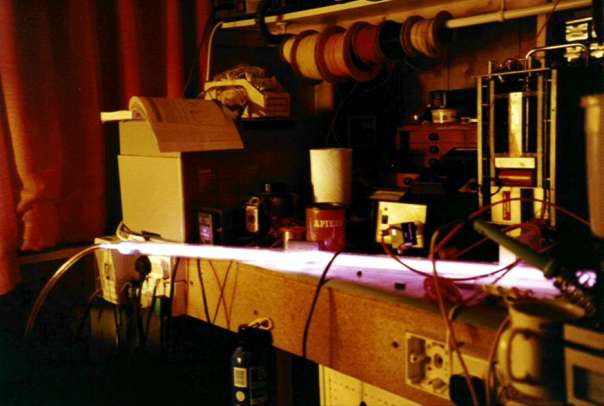
In the above picture, a low pressure air plasma is being generated in a glass tube which is connected to a vacuum pump via a plastic hose. This time a dc current is being used. Direct current plasmas can be deflected by magnetic fields. An 's' bend can be seen in the plasma caused by the presence of a permanent magnet.
Tokamaks used for fusion research require a plasma with a temperature of around 1x108 centigrade. The plasma is confined to the center of the torus shaped cavity by high powered electromagnets.
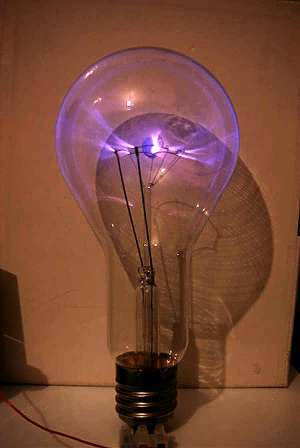
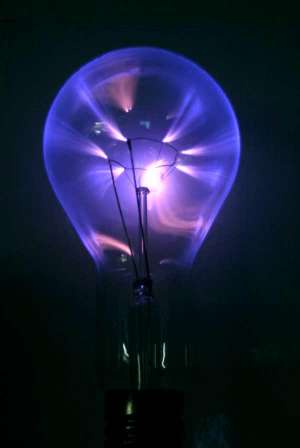
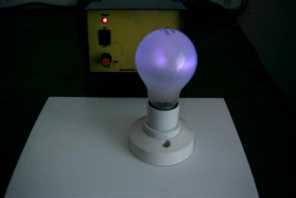 Filament lamps contain a gas at low pressure to help prevent the filament
from evaporating. This gas can be turned into a plasma by applying a high
ac voltage to the terminals of the lamp. In this case, 10kV is being used.
Filament lamps contain a gas at low pressure to help prevent the filament
from evaporating. This gas can be turned into a plasma by applying a high
ac voltage to the terminals of the lamp. In this case, 10kV is being used.
Above left, a 300W Edison Screw lamp is shown. Above right, the same lamp
is shown, but with the room lights off. Purple trailers track over the inside
surface of the glass. The pearl 60W lamp on the left looks rather less
spectacular.
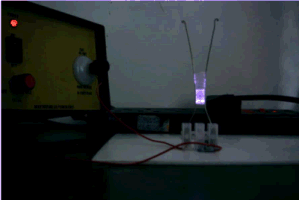 This is a mini jacobs ladder. They are often seen in old science fiction
and horror films. It simply consists of two wires mounted vertically. They
start off close together at the bottom and get progressively further apart
towards the top. A high ac voltage is applied continuously between the wires.
This is a mini jacobs ladder. They are often seen in old science fiction
and horror films. It simply consists of two wires mounted vertically. They
start off close together at the bottom and get progressively further apart
towards the top. A high ac voltage is applied continuously between the wires.
An arc is struck at the bottom where the wires are closest together. This causes
the voltage to drop, preventing further arcs being struck. The air plasma is
extremely hot and so tends to float upwards in the denser air around it. When it
gets near the top, the wires are too far apart for the arc to be maintained and
it extinguishes. The voltage then rises allowing a new arc to strike at the bottom.
On page 2 construction details are given for a simple discharge tube which requires minimal glass work.
| Experiments Menu | Teralab Main Menu | Page 2 |
|---|